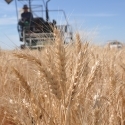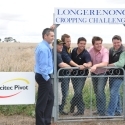24 Jan 2012
Longerenong Cropping Challenge Results 2011
Summary of the results from the 2011 Wheat Challenge.
Thanks to the groups who participated and shared their experiences as well as trying out new strategies.
Highest yields were for Tylers/Agwise and IPL (no significant difference). Three other groups grew better than 4.5 t/ha
The highest gross margin was Tylers/Agwise at $564/ha. Four other groups got gross margins over $500/ha.
The season was a difficult one to match inputs to conditions - the profile was full at sowing, and despite a decile 9 year, seasonal rainfall (May-Nov) was decile 2, and the conditions in September were decile 1.
Some discussion points from the results.
· Difficult to pick anything in terms of outstanding varieties – the results here are the consequence of the whole package rather than an individual “silver bullet”.
· Best yields were over 5 t/ha and the yield prophet prediction was 6 t/ha – so there could have been some unmet potential still on the site. Maybe the very dry September was a problem in achieving this YP potential.
· Tough year to make decent protein – even the high N users tended to stimulate yield more than protein. Lower yields tended to have higher proteins.
· Disease - stripe rust was the main disease; present at varying levels depending on variety susceptibility and use of fungicides. Intake-in-furrow provided some teams good protection up to flag leaf stage while other teams adopted a foliar approach (either one or two applications) I think there is a good trend here - teams that did neither of these strategies were all down the bottom end of the yield table. Obviously there are other contributing factors as well; but there is no doubt that controlling stripe rust helped maintain yield potential.
· Nitrogen was generally not a limiting factor over the whole this season. The two top yielding groups exceeded the predicted N limit maybe because the crops exploited N deeper than the soil test went. Nitrogen use efficiencies for the higher yielding crops were around 50% and less than 40% for the lower yielding crops.
· Up front N was probably associated with lower grain protein but yields were generally good.
· Phosphorus was generally well supplied, and on average across the site, the P offtake was the same at the P applied.
· In determining final gross margin - yield seemed more important than price. Keeping costs down was more important than forcing up quality.
· Variety and stripe rust suceptibility varied among the groups but there were no clear effects noted – effect could be a combination of both variety and fungicide strategy. Teams with no stripe rust control likely took a yield penalty.
· Establishment was generally into burned stubble, except for VicNoTill, who sowed into stubble and probably got better early establishment as there seemed to be more moisture at sowing under the stubble at seeding.
· While the best efforts were made two particular errors should be noted
· While the intention of the Longy Lecturers was to sow Gladius, the seed sown was not that cultivar. It is uncertain what the variety actually was.
· Apologies to Agritech who requested extra N, but this did not occur due to an administrative error.
Summary Table
Additional Resources
Final Challenge Results 2011 Agronomy Summary.pdfSize: 0.07 MB
Final Challenge Results 2011 Costs.pdfSize: 0.06 MB
Final Challenge Results 2011 Nutrient Balances.pdfSize: 0.04 MB
Final Challenge Yields and Prices.pdfSize: 0.06 MB




